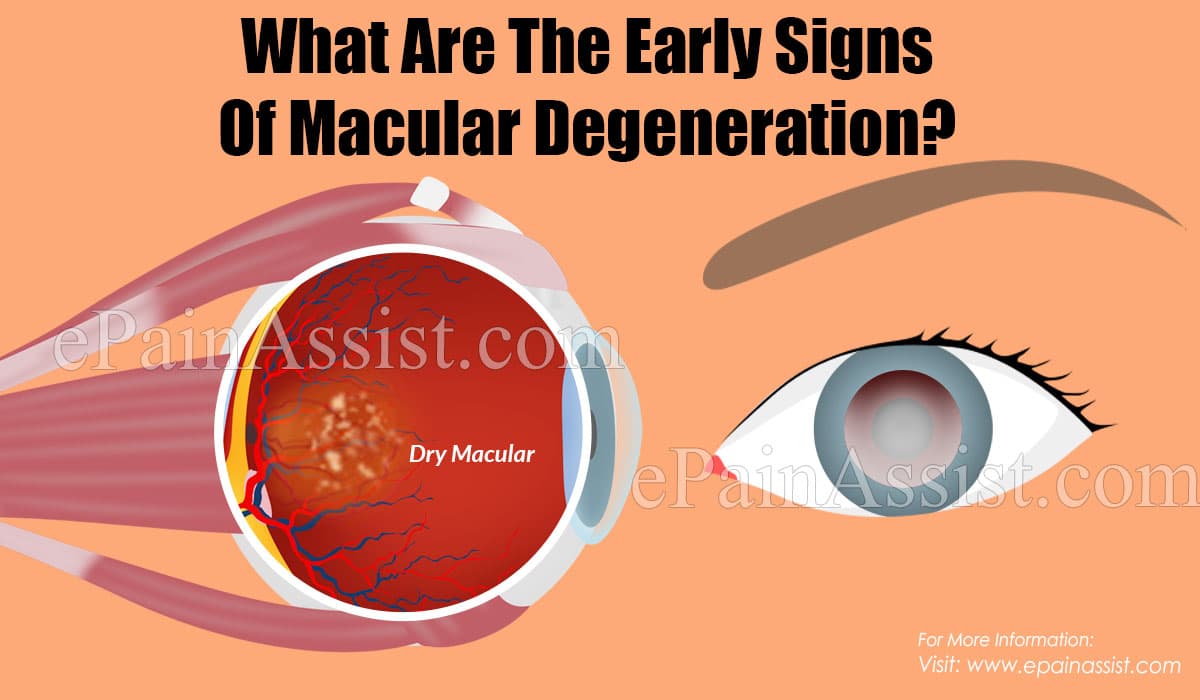Macular degeneration is the term used for the degeneration of the macula, which is the small, tiny area in the center of the retina of the eye. Macula is responsible for visual acuity- or sharpness of the vision. A healthy or normal macula is responsible for the ability recognition of faces, driving, reading and other such activities.
Macular degeneration is one of the most common causes of visual loss in elder people.

What Are The Early Signs Of Macular Degeneration?
Early signs of macular degeneration usually present with a slow, progressive and a painless vision loss.
- In very rare cases, the loss of vision might be sudden.
- One can see shadowy, dark areas in the center of the vision.
- The vision can also be fuzzy or distorted very unusually.
- Straight lines may seem to be twisted or distorted or even parts of straight lines may appear blank and this is an early sign of macular degeneration.
- The central vision may appear to be reduced. This may first occur in one eye and then gradually the other eye might get affected.
- Early sign of macular degeneration is the feel a need for a brighter light to work
- One may not be able to get adapted to low lights when entering suddenly in a dimly lit place.
- Printed words may look increasingly blurry.
- Brightness of colors may look decreased.
- There may be a difficulty in recognizing people’s faces.
Macular degeneration is usually seen to be affecting both the eyes. However, it may start first in one of the eyes and then second eye may be affected later.
In addition to this, there is no effect on the peripheral or the side vision. Hence, total blindness is very rarely caused. And so, if only one eye is affected, one may hardly notice any changes in the vision as the other eye is normal; and it compensates for the weak eye. So, there are high chances that the changes may get unnoticed.
Dry and wet macular degenerations are the two types of this disease.
Dry Macular Degeneration-
Dry macular degeneration is a very early stage of the disease. This may occur due to the thinning of the macula due to the aging process. Also, sometimes a pigment might get deposited on the macula, resulting in the central vision loss. And sometimes, both of these may together be the cause.
There is a slow and progressive vision loss in this type and it is not as severe as the wet type. However, over the years, the dry macular degeneration can slowly and dangerously progress to a condition known as late stage geographic atrophy, which is actually a progressive degradation of the cells of the retina, that can result in severe loss of the vision.
Wet Macular Degeneration-
Out of the cases diagnosed for dry macular degeneration almost 10% of the cases slowly progress and lead to a more severe, damaging and advanced form of the disease, known as wet or neovascular macular degeneration.
- In this type, new blood vessels (neovascular) grow underneath the retina.
- As these new blood vessels are weak, they leak fluid and blood.
- As a result of this leakage, the retinal cells get damaged and start to die off, which creates blind spots in the center of the vision.
- This new growth is actually body’s way gone too wrong, wherein the body creates a new network of blood vessels to supply more oxygen and nutrients to the retina. In reality, this process leads to scarring, which ultimately can lead to severe damage to the vision.
- There are two types of wet macular degeneration-occult and classic.
Conclusion
Macular degeneration is a degenerative disease of the macula, which is the central, tiny portion of the retina of the eye. The macula is responsible for the visual acuity. With macular degeneration due to aging, there is a loss of central vision, resulting in an inability to perform activities like reading, driving and recognizing faces.
- Mayo Clinic. Macular Degeneration. https://www.mayoclinic.org/diseases-conditions/wet-macular-degeneration/symptoms-causes/syc-20351107
- American Academy of Ophthalmology. What Is Macular Degeneration? https://www.aao.org/eye-health/diseases/amd-macular-degeneration
- National Eye Institute. Facts About Age-Related Macular Degeneration. https://www.nei.nih.gov/learn-about-eye-health/eye-conditions-and-diseases/age-related-macular-degeneration
- American Macular Degeneration Foundation. What Is Macular Degeneration? https://www.macular.org/what-macular-degeneration
Also Read:
